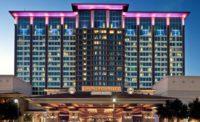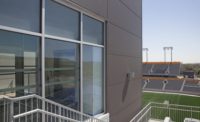The global pandemic changed many rules of the game when it comes to construction practices. Today’s jobsites are more nimble environments, with fewer workers on-site at any given time. Project management playbooks are tightly focused on moving team members on and off the site as efficiently as possible. But comfort, efficiency and fire resistance remain key objectives always in the performance end zone.
Principles of efficient construction, thermal and fire performance were played out in real time as the clock ticked down on construction of Allegiant Stadium, home of the Las Vegas Raiders and UNLV Football. Opened on schedule July 31, 2020, the stadium’s exterior includes 410,614 square feet of curtainwall. Inside, the stadium boasts 65,000 seats and its lanai operable doors invite spectators to take in views of the iconic Las Vegas Strip. Atop it all a transparent dome-shaped roof graces the winning aesthetic.
Driving thermal performance behind the facade
As every coach knows, winning performance relies on a lot of activity that isn’t observable from the stands. That wisdom applies to materials in Allegiant Stadium’s enclosure—including the insulation installed in the panels of the sleek, black, unitized curtain wall façade. The façade panels are massive in scope, spanning 54 feet in width and standing 84 feet in height—dimensions the curtain wall manufacturer Enclose notes are nearly the size of a basketball court.
Inside the panels, Owens Corning® Thermafiber® insulation is essential to providing fire protection that supports life safety and managing the thermal drive that occurs as oppressive external heat pushes into the structure’s cooler interior. The Las Vegas temperature soared to 114 degrees Fahrenheit in both August and September 2020, with 97 days in the year topping 100F or higher. With performance in mind, nine inches of Thermafiber® Firespan 90 insulation was installed in the façade’s panels. This thickness and density reflects the priority the designer placed on creating a comfortable environment. And the material’s fire-resistance supports safety.
Remarking on the design, Chuck Crim, Area Sales Manager at Owens Corning® Thermafiber® stated, “When you look at the side of the stadium – where most of the insulation is installed – you have a combination of glass and metal panels. The installers at the fabrication plant assembled massive metal panels that deliver exceptional R-value that goes above and beyond to support comfort and thermal efficiency.” Crim said that when his team was originally contacted about supplying mineral wool, they expected the focus was on supporting perimeter fire containment design. Mineral wool has long been trusted for its fire-resistant properties. However, in this situation, abundant mineral wool insulation targets thermal performance in an environment where triple digit temperatures are routine.
Fabricating and the facade
Enclos installed the insulation into the aluminum panels at its fabrication plant in Phoenix, Ariz. The insulated panels made the journey from Phoenix to Las Vegas via truck. Following arrival at the construction site, a crane lifted the insulated panels into place as the glass, aluminum and various components of the stadium’s façade were assembled.
“Creating the insulated panels in a fabrication environment provides an exceptional level of control when designing a high-performance enclosure,” stated Crim. A fabricated approach to panel assembly also ensured the panels were kept pristine until they were ready for transport to the job site. Situated directly West of the Mandalay Bay property, massive amounts of soil from a 62-acre build site were excavated prior to façade construction. A high density of other infrastructure around the stadium meant it was important to consider when and where materials were delivered. The ability to produce the façade panels in a fabricated environment, insulate them prior to transport and deliver them at the right time to complement other components and phases of construction helped support an efficient install on a project of scope and scale. The size of the project is perhaps best understood when one considers that two of the nation’s largest general contractors Mortenson and McCarty collaborated on a joint venture to assure the “Silver and Black” had a new home ready for game day in 2020.
Monday morning quarterbacking
Like every game on the gridiron, every construction project has a few unique unexpected turns, and this was the case with the Allegiant Stadium project. As a public/private partnership managed by the City of Las Vegas, a certain percentage of materials had to be sourced through local suppliers, which necessitated vetting and reviewing suppliers. And as noted earlier, another unexpected requirement was the extreme thickness and density of insulating material specified – reflecting the high priority placed on assuring comfort and thermal performance.
But one success metric is never a surprise—collaboration between partners across the AEC chain. Reflecting on the project, Crim stated, “Trust is always non-negotiable. A long history of collaboration between the curtain wall manufacturer and Owens Corning® Thermafiber® created mutual confidence that the project could be executed on time and on spec.”
The Raiders played their first home game of the 2020-21 NFL season in the $1.9B stadium. Their 34-24 win over the New Orleans was broadcast on Monday Night Football in a venue without spectators due to the pandemic. But as the team’s second season in the new stadium is underway, the thermally efficient insulated panels are keeping fans comfortable as both the weather and the action on the gridiron heat up.
On the field and off, insulation can contribute to comfort, fire and sound performance in the enclosure.


